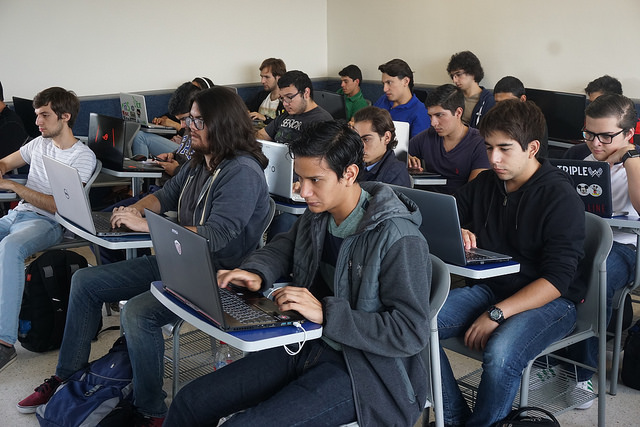An open teaching practice incorporates students as part of a community where collaborative learning is fostered and cross-curricular skills in written and oral communication are developed. In addition, online publications related to the contents of the courses are encouraged, allowing students to develop their own digital portfolio.
Photo: Ken Bauer
By Ken Bauer
kenbauer@itesm.mx
As a teacher, I form part of an open education community and have an extensive background in applying and recommending the use of open tools for education. I like to drive the opening of our teaching practice, because it offers benefits such as: 1) reflecting on our own experience, which is essential for ongoing improvement; 2) posting our experience on the Internet, so as to share with and benefit others within the educational community and other productive sectors of society, and 3) through open practices, we connect with other people who work in similar fields, which helps us to engage in networking.
In the courses I teach, I have confirmed the benefit of motivating my students by participating in an open-practice community, because we live in and therefore must adapt to a highly connected society. The dynamic is that students can check not only their peers’ work, but also the work of other students who took the course beforehand. Therefore, students must create their own online presence by means of a digital portfolio. This favors the creation of a practice community that fosters collaborative learning. Students can explore the content and use all the materials in whatever order suits them best. Some colleagues call this student-centered learning, but I prefer the term “student-directed learning”, since it is another way of describing this practice.
It works like this, students post their projects and assignments on an online blog, in a space in which they are the owners of their data and have full control over deciding what to do with this information once the course has finished. Each student has his or her own blog and what I do, as the teacher, is to have WordPress installed in my hosting account, where, through plugins, I register the URL of their blogs, so that the system will take the content of any recent posts and copy it to my course blog. In this way, when students visit the course page, they can see the posts of all their classmates, even though each student is posting on his/her own space. This is called content syndication and basically that’s the magic behind the whole process. This same solution can be used for courses or publication centers.
data-animation-override>
“I believe that feedback is important, as long as students are given the opportunity to improve.”
For students’ publications, we use a system of suggested search tags so that, for example, anyone looking for how to create a cycle in C ++ will find it easily. Since I have 2 groups of 100 students posting recurrently, the number of posts rises rapidly, making a search control highly useful. Each semester I create a new course blog, which entails some maintenance activities.
With this, I endeavor to develop in my students the transversal competencies of written communication and oral communication, and promote online publications related to the content of the courses that I teach or of workshops in general.
One strategy that I put into practice in my courses is that the activities do not have a schedule, which means that the deadline for handing in all the assignments is the last day of classes. For those who psychologically need a deadline (because otherwise they would not do anything), I think we should guide them in learning how to manage their own agenda properly. Some teachers think that by implementing this strategy many students would leave everything until the last minute. However, my experience has shown that this is not the case, since this way of working reduces students’ stress levels and most of them complete the activities early. I believe that feedback is important, as long as students are given the opportunity to improve. Therefore, if students hand in their homework and obtain unsatisfactory results and want to improve their grades, I give them the opportunity to do the work again and I re-grade it. In this way, they learn that there is nothing wrong with making mistakes and that they can try again.
data-animation-override>
“Teachers’ time is undoubtedly finite, but we must ask ourselves what we will invest it in and what the cost-benefit will be inside and outside the classroom.”
Teachers’ time is undoubtedly finite, but we must ask ourselves what we will invest it in and what the cost-benefit will be inside and outside the classroom. It is important to use technology when it saves us time so we can use it on something else. You cannot spend more time on one activity without having to sacrifice the time you should be spending on another.
I would like to invite you to read some of the testimonials of former students about their learning experience in my courses. Finally, I urge the community of teachers to open their doors to their colleagues at the campuses in order to share their best practices. Please do not hesitate to contact me for further information on this and other topics by email, Twitter @ken_bauer or through my blog https://kenbauer.me
About the author
Ken Bauer is a professor in the Computer Science Department at Tecnológico de Monterrey, Campus Guadalajara. His interests include open pedagogy, flipped learning, connectivism and software engineering . Ken has offered talks on these topics internationally and is currently the board chair of the Flipped Learning Network.
This article from Observatory of the Institute for the Future of Education may be shared under the terms of the license CC BY-NC-SA 4.0 
)
)


)